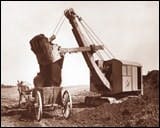After World War I ended, the Manitowoc Shipbuilding Co. of Manitowoc, Wis., started to look to diversify its product base. Spurred on by government contracts during the War, the shipbuilding side of the company's manufacturing facilities had quadrupled since its founding in 1902. The company had purchased the Manitowoc Steam Boiler Works and Manitowoc Foundry to expand its manufacturing capability.
In the early 1920s, as wartime government orders diminished, management found increased difficulty in utilizing the modern machine shop and other facilities built during the war.
Founding officers Charles C. West, Elias Gunnell, and L.E. Geer also owned an interest in the American Sand and Gravel Co. They observed a fleet of mobile cranes called "Speedcranes" busily excavating and loading materials. They concluded that the manufacture of these cranes would be just the thing to keep the machine shop busy.
The cranes were built in Fort Wayne, Ind., for Roy and Charles Moore of Chicago, and they were interested in obtaining a new manufacturer. In 1925, Manitowoc Shipbuilding agreed to manufacture the cranes under the Moore patents. Roy Moore joined the Manitowoc staff as crane designer.
The Moore "Speedcrane" was a steam-powered, wheel-mounted machine that could operate as a 15-ton crane or carry a ¾-yard bucket. The first crane built in Manitowoc's factory was sold to the Reiss Coal Co. of Sheboygan, Wis., a long-time coal supplier to Manitowoc Shipbulding, for use as a material handler in its yard.
The crane worked well, but changes had to be made. Steam power was losing ground to internal combustion engines, so Moore soon redesigned his crane to accommodate a gasoline engine. He also beefed up the design with cast steel carbody to replace the original riveted construction and, because of Caterpillar's tractor success, introduced a crawler base for increased stability and traction.
The new machine, the first true Manitowoc universal crane/excavator, could be converted to operate as a crane, shovel, dragline or trench hoe. It was launched in 1927 as the model 125 (later called the 1500) with 1¼-cubic-yard capacity.
From this early model, Manitowoc gradually introduced a wide range of cranes and excavators incorporating the latest technology. A new drum clutch claiming superior smooth application to handle heavy loads more gently was designed, and a disc-type swing clutch was developed to lessen the wear and tear on clutches due to heating. In 1932, Manitowoc introduced the completely redesigned 1½-yard model 150 (later renumbered the 3000). In 1936, the former 1500 was upgraded to the 2000, a fully convertible excavator powered by a 115-hp engine and weighing just over 42 tons as a shovel.
In order to fulfill a major submarine-building contract during World War II, Manitowoc's crane division built two Model 3900 cranes capable of lifting 30 tons at a 30-foot radius, its largest cranes to date. The 3900 and its upgrades remained in the product line for some four decades, and larger models of similar design were produced.
In the 1960s and 1970s, Manitowoc created an enviable name for itself in the surface-mining industry with its large diesel-powered shovels and draglines. Today, Manitowoc remains a world leader in heavy-lift cranes with capacities reaching to 1,000 tons.
You can read more about the evolution of construction equipment in Keith Haddock's illustrated books available in most bookstores. Also, consider a membership in the Historical Construction Equipment Association, www.hcea.net.





